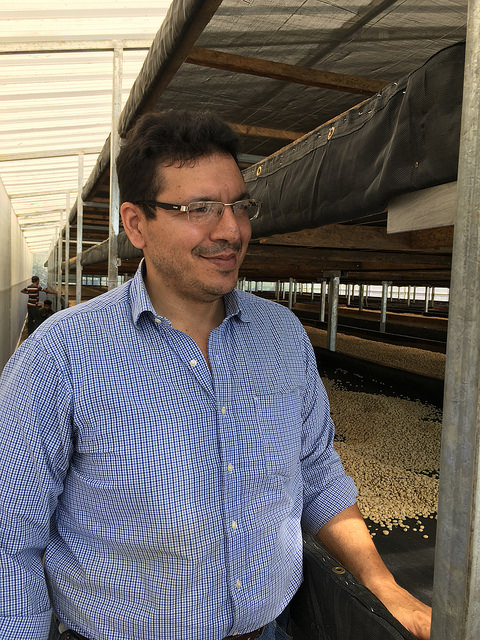Santa Barbara, Honduras
Nelson Ramirez’s challenge has always been different to other farmers in Santa Barbara. His goal is scale. He is by far the biggest farmer on the hill with 14 hectares in production.
Nelson is an educated man with experience in planning, structuring and accounting, and from the outset he approached his new farm strategically. When we first met seven years ago he had just begun work on Finca Chely, named after his mother, and he showed me the map he had created with soil analyses from each plot. At that time the farm was producing 50-60 bags. Nelson is now producing ten times that volume, almost two containers.
Nelson acquired additional farmland in other parts of the hill, and this undoubtably contributed to his increased yield. However it is in large part due to Nelson’s hard work: re-planting, new planting, careful husbandry and appropriate fertilization.
The challenges of scale: processing
Since we were at Chely last year, Nelson has built a huge drying facility, even bigger than at Bella Vista, our dry mill and export partner in Antigua, Guatemala. I respect the effort and the initiative, but I expressed some doubts about the design. Nelson created the facility to protect the coffee regardless of the weather, an undeniable benefit, but I’m not sure how well it dries the coffee.
I suggested some obvious solutions, such as moving coffees around depending on sun exposure and height above the ground, and monitoring the temperature, humidity and drying time per lot to compare this data to cup quality. He agreed these were easy things to do, given the monitoring and data collection he already does.
Luis Maldonado, production manager at Finca Chely
The challenges of scale: selection
No amount of infrastructure can solve Nelson’s biggest challenge with a farm of this scale:developing a red-and-mature picking culture. Nelson needs to employ many more pickers than other farmers in this community, about 80 in the peak of harvest, and good pickers are hard to come by.
He pays 55 Lempiras for each 20 liter or 5 gallon bucket of cherries, approximately $2.40 USD. According to Nelson this is 1.5 times the going rate. At least half of his team are indigenous people from Guatemala and he believes they do a better job than the local pickers at selecting the ripe cherries. This is something of a sore point in the region. Fidel Paz Sr. at San Vicente believes it's a problem with the culture in Honduras that incentivizes earning just enough to survive, and no more. I am not sure I subscribe to his views, but as we have been working together since 2005, I respect his opinion.
The challenge we all face: climate change
Increasing temperatures and higher altitude planting mean later harvests and longer picking seasons. This can be challenging for everyone involved, as we all want to be first-in-market with every origin. However the risk of ignoring the late harvests is missing out on some exceptional coffees.
Some of these late harvest coffees from Santa Barbara have arrived on the west coast of the US and are available for pickup/delivery from The Annex, CA.
Nelson's lot is a catuai that cups with notes of black tea, raisin, brown sugar (85.75 pts). It's available at USD $3.90/lb and you can contact Colleen for samples.
For more info on other available Santa Barbara lots, please see our offer list.
Robert W



